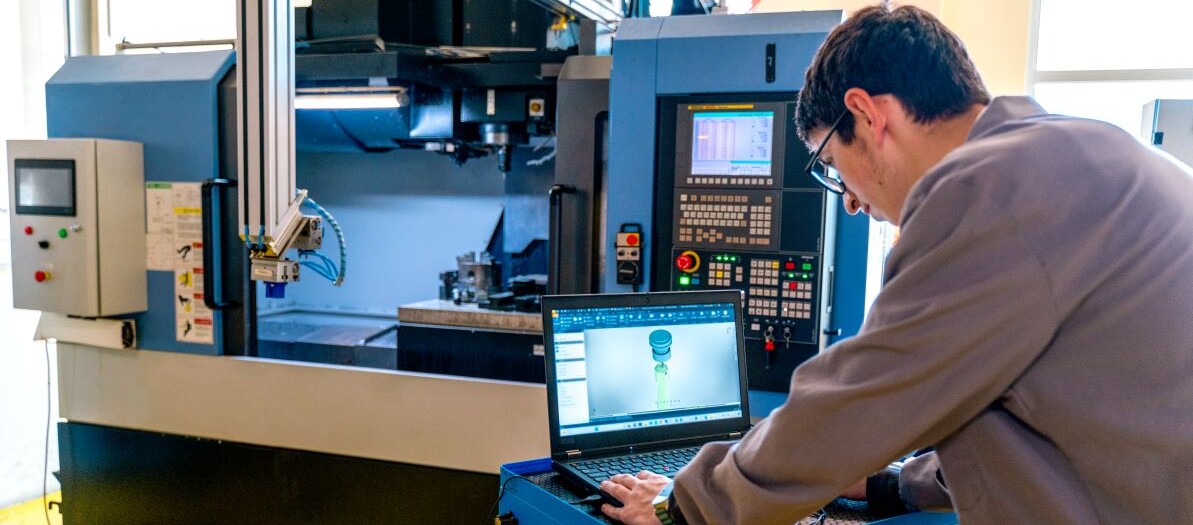Focus points
- Why CNC Upgrades Are a Priority Now
- Technological Trends Driving Investment:
- CNC Upgrades That Drive Innovation and Growth
- EU Trends and Incentives in AI Adoption
Why CNC Upgrades Are a Priority Now
Artificial intelligence (AI) is now capable of automating up to 80% of CNC manufacturing engineering. For businesses struggling with workforce gaps and rising costs, this represents a direct path to efficiency and resilience.
The technological upgrade is a strategic move toward competitiveness in an industry that demands precision, speed, innovation and strong partnership.

Key Challenges and Technology Drivers for CNC Upgrades
Labor Shortages: Manufacturing businesses are facing one of its most significant labor challenges in decades. A shortage of skilled CNC programmers is leaving businesses unable to keep up with demand.
Automation is becoming the most reliable solution. With AI-driven CAM software, companies can generate G-code automatically. This code tells machines how to move and operate, so teams can spend less time on programming and more time on supervision and process improvements.
Energy and Cost Efficiency: Energy continues to be one of the biggest expenses for European manufacturers,
New-generation CNC machines are engineered with energy efficiency in mind. Smart drives, regenerative braking, and energy monitoring can significantly cut energy use. For many companies, these savings alone justify an upgrade.
Technological Trends Driving Investment:
AI-Powered Programming: AI systems now generate and optimize tool paths, reducing setup times and cutting down on trial-and-error. This not only improves efficiency but also lowers material waste.
Multi-Axis CNC Systems: Machines with five, seven, or even nine axes are increasingly in demand. They can produce complex geometries in a single setup, speeding up production and ensuring higher precision.
Integration with Digital Twins: Advanced CNC upgrades are designed to integrate seamlessly into a broader digital manufacturing ecosystem, providing real-time data for better decision-making.
CNC Upgrades That Drive Innovation and Growth
The real value of CNC upgrades goes much further: they pave the way for innovation and long-term growth.
Beyond saving money, modern systems allow manufacturers to take on more complex projects and enter markets such as aerospace, healthcare, and automotive, where precision and innovation are essential.
The connected factory brings everything together. AI-driven CNC machines linked in a digital network constantly share data and insights. With digital twins, manufacturers can test production before it begins, reducing errors, minimizing waste, and boosting overall efficiency.
CNC upgrades deliver real-world benefits: fewer breakdowns with smart monitoring, smarter products through advanced machining, and people empowered to focus on strategy and quality.
EU Trends and Incentives in AI Adoption
According to Eurostat, around 28% of European manufacturing enterprises have adopted some form of AI-driven process automation.
However, adoption is uneven. Large companies tend to move faster, while SMEs often delay investments due to budget constraints. This September’s budgeting cycle is critical for narrowing that gap.
- Germany: A leader in Industry 4.0, Germany has invested heavily in smart factories. Federal initiatives like “Industrie 2030” support digital transformation through grants and training programs, making it one of the most advanced ecosystems in Europe.
- France: France offers one of Europe’s most attractive R&D tax credit systems. Investments in CNC upgrades and AI-driven technologies are often eligible for significant deductions, reducing financial risk for manufacturers.
- Italy: Italy’s “Transition 4.0” plan provides tax credits for new capital goods, including CNC machinery. This has led to rapid modernization, particularly in sectors like automotive and precision engineering.
- Poland: As Eastern Europe’s industrial hub, Poland is accelerating modernization through EU structural funds and national grants. Incentives are pushing SMEs to adopt digital tools faster, closing the gap with Western Europe.
- Spain: Spain is making strides in digital manufacturing, supported by EU recovery funds. Investments in energy-efficient machinery are prioritized, reflecting the country’s focus on reducing dependence on costly imports.
- United Kingdom: Post-Brexit, the UK has maintained strong support for advanced manufacturing through programs like “Made Smarter.” Tax reliefs for R&D and capital investment are helping companies adopt AI-driven CNC upgrades despite broader economic uncertainties.
At the EU level, funding from the European Investment Bank and the Recovery and Resilience Facility continues to back digital and green manufacturing initiatives. These programs are designed to lower the financial barriers for businesses of all sizes and accelerate the adoption of energy-efficient and AI-powered solutions.
Final thoughts
September marks a decisive moment for European manufacturers. Budget planning for 2026 is underway, and the choices made now will define competitiveness for years to come.
AI-driven CNC upgrades, multi-axis systems, and connected factories are now essential for resilience and profitability. The future of CNC machining belongs to those who act decisively now.
For more insights and industry updates, visit Inside Business, the europages blog, to explore more articles on CNC technology and AI.

